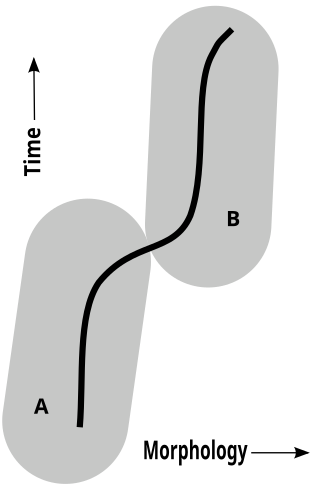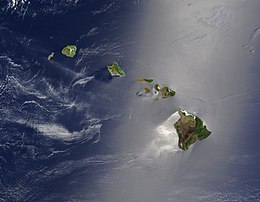
In evolutionary biology, punctuated equilibrium is a theory that proposes that once a species appears in the fossil record, the population will become stable, showing little evolutionary change for most of its geological history. This state of little or no morphological change is called stasis. When significant evolutionary change occurs, the theory proposes that it is generally restricted to rare and geologically rapid events of branching speciation called cladogenesis. Cladogenesis is the process by which a species splits into two distinct species, rather than one species gradually transforming into another.
Speciation is the evolutionary process by which populations evolve to become distinct species. The biologist Orator F. Cook coined the term in 1906 for cladogenesis, the splitting of lineages, as opposed to anagenesis, phyletic evolution within lineages. Charles Darwin was the first to describe the role of natural selection in speciation in his 1859 book On the Origin of Species. He also identified sexual selection as a likely mechanism, but found it problematic.
The molecular clock is a figurative term for a technique that uses the mutation rate of biomolecules to deduce the time in prehistory when two or more life forms diverged. The biomolecular data used for such calculations are usually nucleotide sequences for DNA, RNA, or amino acid sequences for proteins.

A living fossil is an extant taxon that phenotypically resembles related species known only from the fossil record. To be considered a living fossil, the fossil species must be old relative to the time of origin of the extant clade. Living fossils commonly are of species-poor lineages, but they need not be. While the body plan of a living fossil remains superficially similar, it is never the same species as the remote relatives it resembles, because genetic drift would inevitably change its chromosomal structure.
Anagenesis is the gradual evolution of a species that continues to exist as an interbreeding population. This contrasts with cladogenesis, which occurs when there is branching or splitting, leading to two or more lineages and resulting in separate species. Anagenesis does not always lead to the formation of a new species from an ancestral species. When speciation does occur as different lineages branch off and cease to interbreed, a core group may continue to be defined as the original species. The evolution of this group, without extinction or species selection, is anagenesis.

The biodiversity of New Zealand, a large island country located in the south-western Pacific Ocean, is varied and distinctive. The species of New Zealand accumulated over many millions of years as lineages evolved in the local circumstances. New Zealand's pre-human biodiversity exhibited high levels of species endemism, but has experienced episodes of biological turnover. Global extinction approximately 65 Ma resulted in the loss of fauna such as non-avian dinosaurs, pterosaurs and marine reptiles e.g. mosasaurs, elasmosaurs and plesiosaurs. The ancient fauna is not well known, but at least one species of terrestrial mammal existed in New Zealand around 19 Ma. For at least several million years before the arrival of human and commensal species, the islands had no terrestrial mammals except for bats and seals, the main component of the terrestrial fauna being insects and birds. As recently as the 14th century a component has been introduced by humans, including many terrestrial mammals.

Pseudoextinction of a species occurs when all members of the species are extinct, but members of a daughter species remain alive. The term pseudoextinction refers to the evolution of a species into a new form, with the resultant disappearance of the ancestral form. Pseudoextinction results in the relationship between ancestor and descendant still existing even though the ancestor species no longer exists.
Evidence of common descent of living organisms has been discovered by scientists researching in a variety of disciplines over many decades, demonstrating that all life on Earth comes from a single ancestor. This forms an important part of the evidence on which evolutionary theory rests, demonstrates that evolution does occur, and illustrates the processes that created Earth's biodiversity. It supports the modern evolutionary synthesis—the current scientific theory that explains how and why life changes over time. Evolutionary biologists document evidence of common descent, all the way back to the last universal common ancestor, by developing testable predictions, testing hypotheses, and constructing theories that illustrate and describe its causes.

The Hominini form a taxonomic tribe of the subfamily Homininae ("hominines"). Hominini includes the extant genera Homo (humans) and Pan and in standard usage excludes the genus Gorilla (gorillas).

Penion sulcatus is a species of medium-to-large predatory marine snail or whelk, commonly called the northern siphon whelk or kākara nui in Māori, belonging to the whelk family Austrosiphonidae.

Antarctoneptunea benthicola is a species of small-to-medium-sized predatory sea snail or whelk, a marine gastropod mollusc in the family Austrosiphonidae.

Penion chathamensis is a species of very large predatory sea snail or whelk, a marine gastropod mollusc in the family Austrosiphonidae.
A paraspecies is a species, living or fossil, that gave rise to one or more daughter species without itself becoming extinct. Geographically widespread species that have given rise to one or more daughter species as peripheral isolates without themselves becoming extinct are examples of paraspecies.
A species is often defined as the largest group of organisms in which any two individuals of the appropriate sexes or mating types can produce fertile offspring, typically by sexual reproduction. It is the basic unit of classification and a taxonomic rank of an organism, as well as a unit of biodiversity. Other ways of defining species include their karyotype, DNA sequence, morphology, behaviour, or ecological niche. In addition, paleontologists use the concept of the chronospecies since fossil reproduction cannot be examined.

Cominella maculosa, common name the spotted whelk, is a species of predatory sea snail, a marine gastropod mollusc in the family Cominellidae, the true whelks.
The chimpanzee–human last common ancestor (CHLCA) is the last common ancestor shared by the extant Homo (human) and Pan genera of Hominini. Estimates of the divergence date vary widely from thirteen to five million years ago.

Antarctoneptunea is a genus of sea snails, marine gastropod mollusks in the whelk family Austrosiphonidae.

Penion maximus is a species of very large predatory sea snail or whelk, commonly known as giant whelk or great whelk, a marine gastropod mollusc in the family Austrosiphonidae.
This glossary of genetics and evolutionary biology is a list of definitions of terms and concepts used in the study of genetics and evolutionary biology, as well as sub-disciplines and related fields, with an emphasis on classical genetics, quantitative genetics, population biology, phylogenetics, speciation, and systematics. Overlapping and related terms can be found in Glossary of cellular and molecular biology, Glossary of ecology, and Glossary of biology.

Mary Morgan-Richards is a New Zealand biologist, and as of 2019 is a full professor at Massey University.












